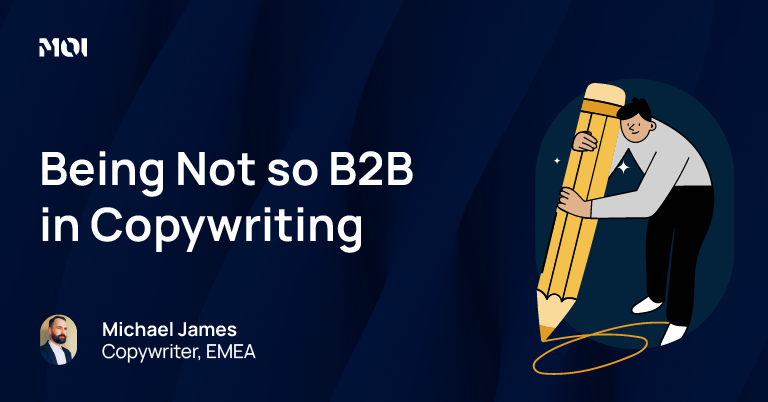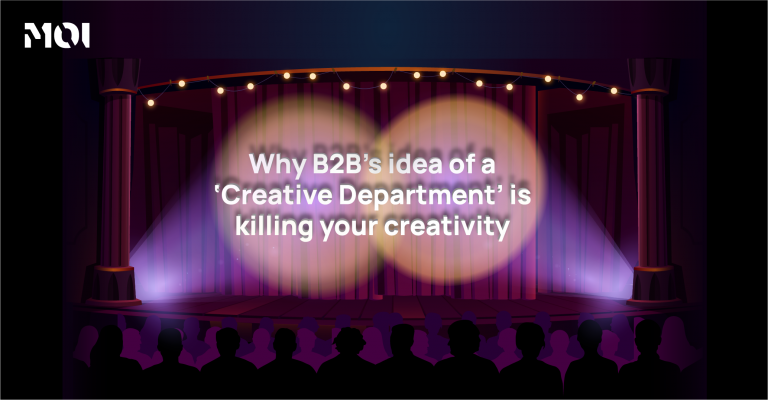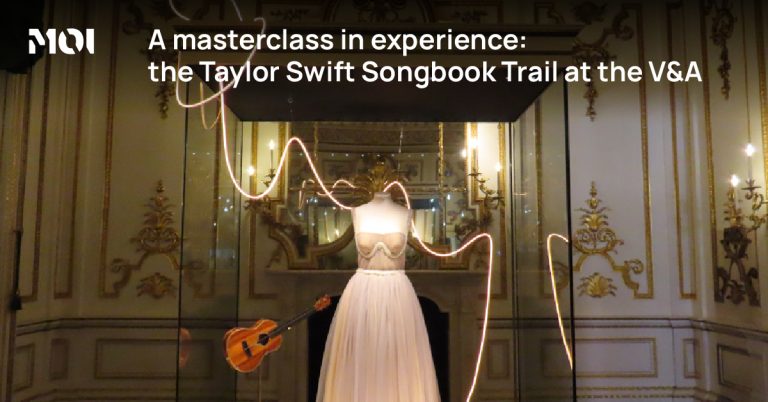
Bringing the interest back to business
Before I began copywriting for B2B marketing, I was asked by a colleague if I thought B2B would be interesting enough for me, considering my background reporting on a range of vibrant topics from celebrity to politics, current affairs to lifestyle features.
Of course, B2B is so varied that it isn’t boring at all, but I could tell where the question was coming from. This genre is not known for its entertainment value and here lies the problem. The copywriting approach that’s gone before just hasn’t hit the mark. If it had, B2B wouldn’t have this reputation. So, it’s time to switch things up, something that MOI are already doing with their Not so B2B-taglined approach.
I answered that if there wasn’t any interest there, it was my job to bring it.
The element of surprise
Some time ago, at the beginning of my journalism training, I remember writing an expressive, entertaining feature – and being asked by a tutor to tone it down. I did, of course, but it was all well-intentioned – I wanted to write what I would want to read. I wanted the fun – or what advertising guru Rory Sutherland told me recently – that element of surprise and emotion. And since embarking on a writing career – I’ve found that’s what everyone wants to read, really, no matter who they are.
That same tutor elaborated that it’s always easier to tone it down than tone it up. Through my writing career, when it comes to B2B writing, I rarely hear anyone asking to tone it down. In fact, it’s rare that B2B content even makes its mark as to be part of such a conversation. In other words, it’s forgettable.
Making it conversational
We want to be aware just how new content is put in front of people. On LinkedIn alone, that’s 2 million posts, articles or videos. Every day. Potential readers are simply not going to prioritise a piece unless it’s written in a way that gets and holds their attention.
There’s a reason that behind every one broadsheet there are ten copies or so of the Daily Mail sold. Now I’m not talking about dumbing down the content to get attention, but in this era of information excess, few people want to read complicated or drab copy when they get in from a long day at the office. Even the better-selling of the broadsheets are written in a conversational style – they’re hardly white papers. And unfortunately that white paper-type read is what B2B is known for – articles which are about as interesting as reading the dictionary.
AI might save time, but it isn’t always the most creative approach
Although current AI can produce a fairly adequate brief to work from, it’s missing that energy that only creative humans can bring when it comes to writing. Current AI produces uncreative copy and as I’ve said before, AI is only going to be a threat to uncreative writers, because it’s very good at mimicking them.
There’s those familiar overused ‘AI words’ we all know so well in B2B – words like leverage, delve, seamless, multifaceted or navigate. Some of these words are useful – so I’m not saying don’t use them – but since AI has come in, we tend to hear words like these on-repeat.
Use AI for research, if you want, but make sure you bring your personality to the writing. You can still write to brief whilst keeping that interesting, creative element that is specifically human. I know AI can save time, but you still want to take the time to double-check the copy you are putting out there and make sure it’s not just sounding like everything else.
3 tips for creating copy that’s Not so B2B
1. Put yourselves in the position of the audience when it comes to writing style.
Ask yourself, would I read it? If you wouldn’t read it, why do you expect anyone else to? I’ve heard a few times people suggesting “oh but accountants love this style” when talking about bland B2B copy they themselves don’t like, forgetting that accountants are people too who like interesting writing just as much as – if not more than – the next person. It may be a subject totally out of your frame of reference, but you can still write to brief whilst in a way that is clearly interesting and has that head-turning ingredient to it. I think it’s important to understand that being intelligent or factual – and being conversational – aren’t mutually exclusive.
2.Get creative with content.
In your overall copy plan, don’t be afraid of experimenting with alternative content too. It’s one of the reasons I brought front-page interviews with people from all different backgrounds and professions to MOI’s new zine Heads Up Creative. Whilst it’s unconventional to use artist-led interviews talking about art in a B2B magazine, it shouldn’t be. I know several tech company owners who are big collectors of art and either way as people, we all have many different interests. You could also mix it up by writing articles about things we all relate to in with our jobs, such as experiences of online meetings vs in-person, how to resolve differences with colleagues or how to give a great presentation.
3.Be sparing with your use of AI.
After any research phases, be sure you bring your personality to the final draft, changing any ‘AI sounding’ words as you edit. AI can may save time, but you still want to take the time to double-check the copy you are putting out there and make sure it’s not just like hundreds if not thousands of other AI-authored articles for attention.
Writer Samuel Johnson said in the 18th Century “When a man is tired of London, he is tired of life”. If you replace the word London with B2B, you may realise that perhaps it’s not the subject matter that needs to change – but the perspective. If there’s something missing – bring it. It’s time to write in a Not so B2B way.


